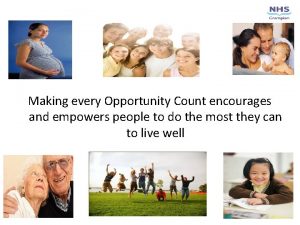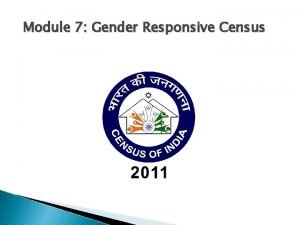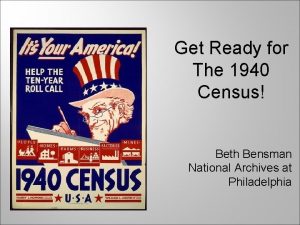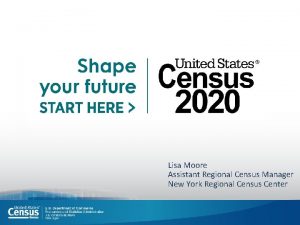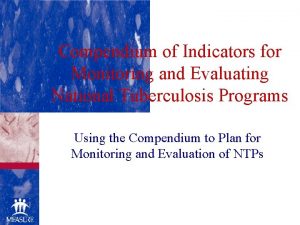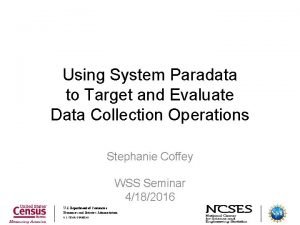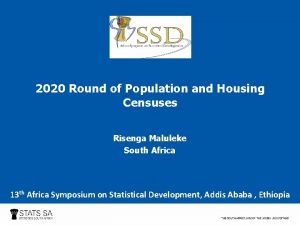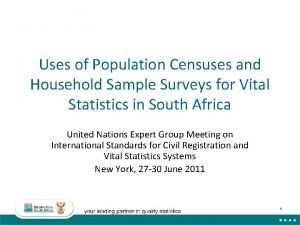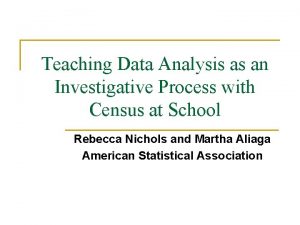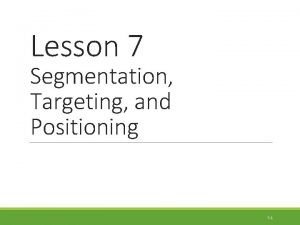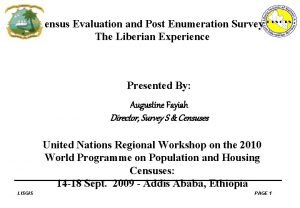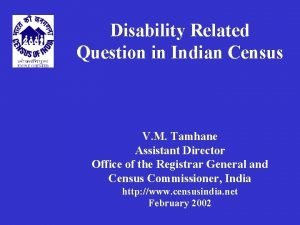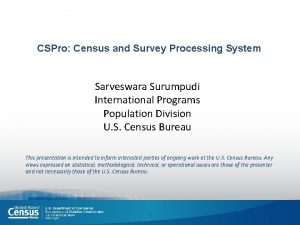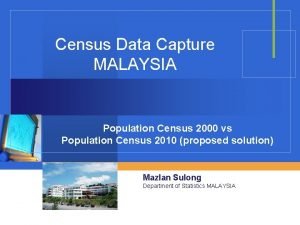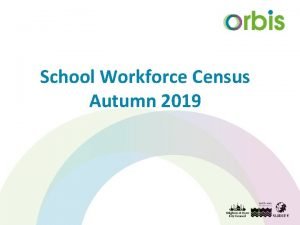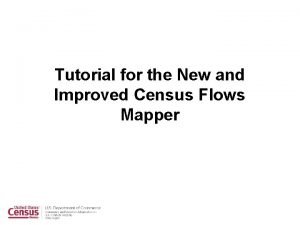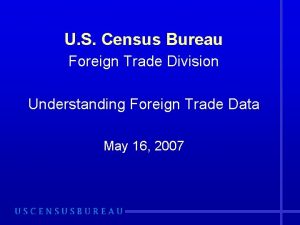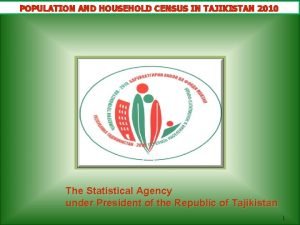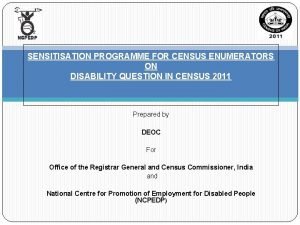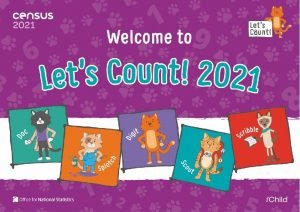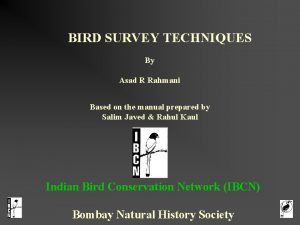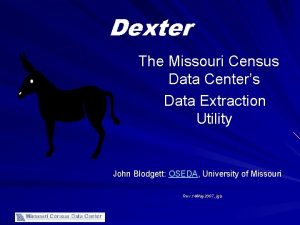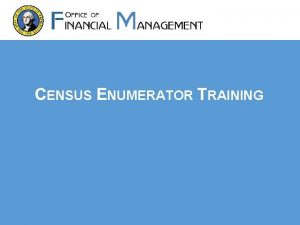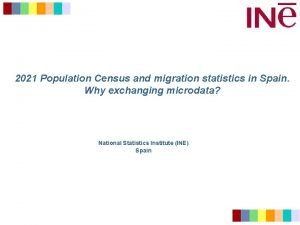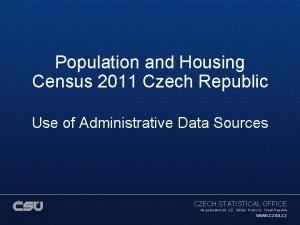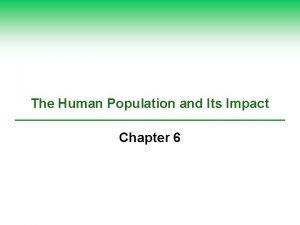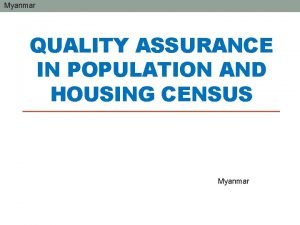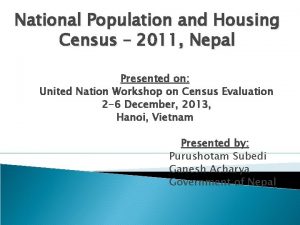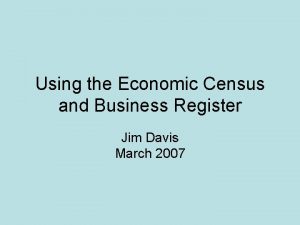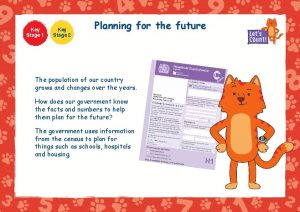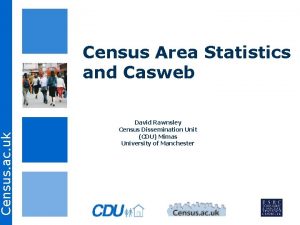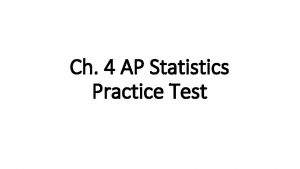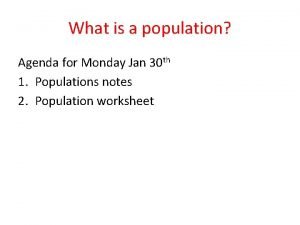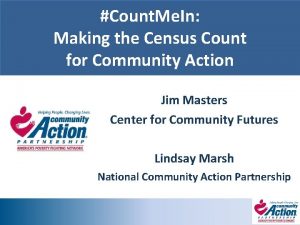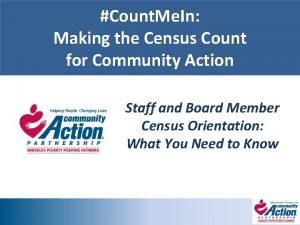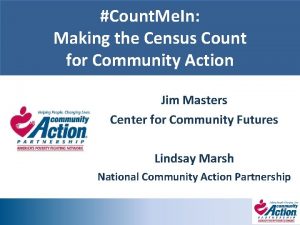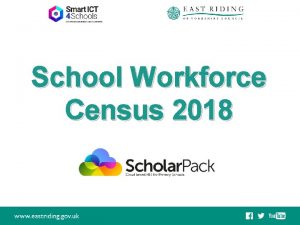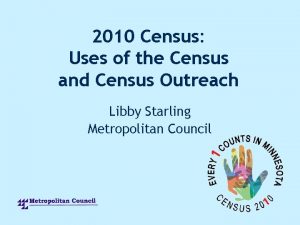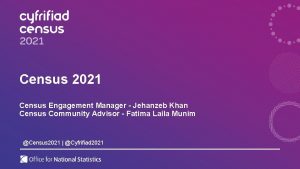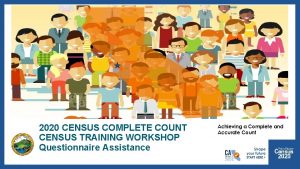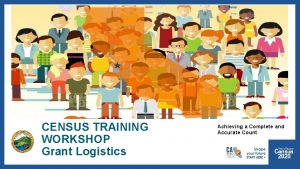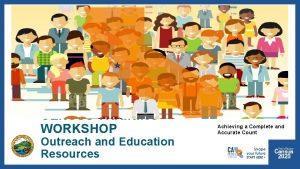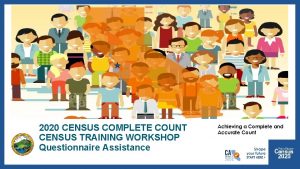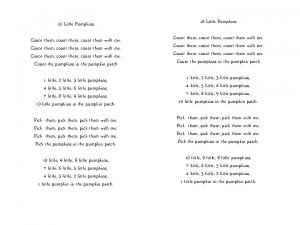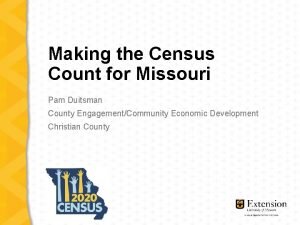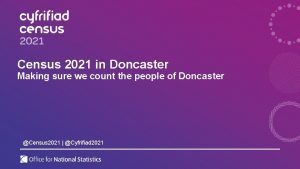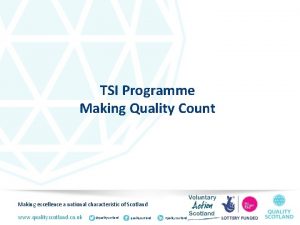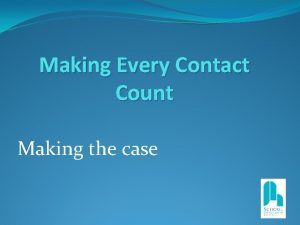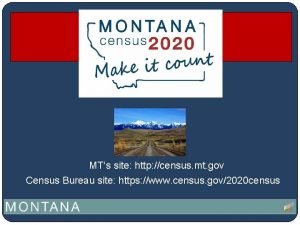Count Me In Making the Census Count for








































































- Slides: 72

#Count. Me. In: Making the Census Count for Community Action Jim Masters Center for Community Futures Lindsay Marsh Community Action Partnership

Agenda • What is the Census & Why does it matter? • Get out the Count ‐ what is being done? • Get out the Count ‐ what can you do? – Messaging that works with different populations • Next Steps and Questions

Lay of the Land • What do you already know about the Census? • What are you already doing for Census engagement? • What do you worry about?

What is the Census?

“Representatives and direct Taxes shall be apportioned among the several States which may be included within this Union, according to their respective numbers, counting the whole number of persons in each State. The actual enumeration shall be made…within every subsequent term of ten years, in such manner as they shall by law direct” ‐ US Constitution, Article 1, Section 2* *Language adjusted to reflect Amendment XIV, Article II to US Constitution, July 9, 1868

The 2020 Census Questions • • • Age – in years, month, day and year of birth for each household member Hispanic Origin – is this person Hispanic; if yes, which country of origin Race – mark one or more boxes and print origins Relationship – How is this person related to Person 1 Sex – gender: male or female Tenure (owner/renter) – Is this house, apartment, or mobile home • Operational Questions: – How many people lived here on April 1, 2020? – Were additional people staying here on April 1? – Telephone number, name of person filling out the census.

Census Data is Used To… • Apportion representation among states – Congressional Members • Draw congressional and state legislative districts, school districts, and voting precincts • Distribute federal dollars to states • Inform government planning decisions at the federal, tribal, state and local level • Inform organizational decisions (e. g. , where to locate, size of market, etc. ) of businesses and non‐profits • Enforce voting rights and civil rights legislation

2020 Census Counting The Population – Key Dates • March 12 -20: Invitations sent to respond online • March 16 -April 3: Reminder letters and postcards sent • April 1: Census Day • April 8 -16: Reminder letters sent with paper questionnaire • April 20 -27: Final postcard sent before in person follow up • May 4 - through July : Non‐Response follow up visit

2020 Census Counting The Population - Strategy • 95% of households will receive their census invitation by mail • 5% of households will receive their census invitation when a census taker drops it off • Less than 1% of households will be counted in person by a census taker, instead of being invited to respond on their own • An estimated 40% of households will require in person follow up

How will we get our forms? • It’s helpful for people to know how they will receive their Census invitation, so they know how to watch for it: – The CUNY map shows which areas will get invitations in the mail to go online vs. print copies first vs. having them dropped in rural areas. – These maps also show why populations might be hard to count and help developing messaging. – If someone doesn’t get an invitation, they can and should still fill out the form. Direct them to call the tollfree numbers or go online to complete their Census.

2020 Census Economics • The Census hires 100, 000 s of people a cycle, and will spend over $15 BILLION* to complete the count • The average cost for counting a household has gone up dramatically due to a changing political climate, increase in immigration, the rise of technology and a variety of other factors: 1970: $16. 2020: $107 • Every person counted is equal to ~$2, 000 in funding to your community a year – each year, for ten years! *‐census/https: //www. gao. gov/highrisk/2020_decennial_census/why_did_study#t=1, https: //www. census. gov/fieldjobs

The 2020 Census- The Environment

The Hard-To-Count Are:

The Bureau asks for help to locate and persuade people who are Hard-To-Count

Economics and HTC: Follow Up • You can help the Census hire those 500, 000! • Hiring people from communities that are Hard to Count means: – Jobs for people: good hourly wages + mileage, flexible PT/FT – And that people are working for the Census, sound, look and act like others in their community; builds trust. Jobs & Pay Rates are on the Census website 2020 Census jobs online on the 2020 Census website

Why Does the Census Matter to Community Action?

Why Community Action? Populations that are the hardest to count or are the least likely to fill out the census happen to walk through our doors every day. This is why we are involved; we are trusted messengers who can raise the issue of the Census with our customers and explain why it’s safe, easy, and important. The populations we serve are often the most undercounted, which means our communities lose their fair share of dollars and representation

Census Data Drives Dollars In 2016, 15 federal programs most used by CAAs relied on Census data to distribute $77 billion or 9% of $864 billion total federal program spending

Get Out The Count – What Is Being Done?

US Census Bureau: Partner Efforts

US Census Bureau: Partner Efforts Your Regional Office

US Census Bureau: Partner Efforts Your Regional Office

US Census Bureau: Partner Efforts Your Regional Office

US Census Bureau: Partner Efforts Your Regional Office

US Census Bureau: Partner Efforts Your Regional Office

US Census Bureau: Partner Efforts Your Regional Office

US Census Bureau: Partner Efforts Your Regional Office

Complete Count Committees (CCCs): • Utilize local knowledge and resources to promote the Census through locally based outreach efforts • Provide a vehicle for coordinating efforts between tribal, state, and local governments; communities; and the Census Bureau • Help the Census Bureau get a complete count through partnerships with local governments and community organizations • Find existing Complete Count Committees on the Census website

Census Counts 2020 Visit www. Census. Counts. org to find resources from our partners. Then take the pledge to be counted & educate your community about the Census!

Census Counts 2020

Engage with Partners • The Census Partnership Specialists are trained to help non‐profits like our agencies engage customers with the Census – They can come train your agencies; they also have pamphlets, fliers, and Census branded giveaways • Our Census Counts 2020 coalition members – there are other entities doing census work in your area. – The lists of state leads and hubs to work with is HERE

Community Action Counts What the Partnership is Doing: • Educate & increase awareness • Mobilize the network to act • Curate and generate resources specific to Community Action • Equip agencies to conduct effective local outreach efforts • 10 member working group

Community Action Counts www. Community. Action. Partnership. com/Census-2020

Community Action Complete Count Committee (CACCC) Each Agency, Association, & State Office Should Nominate 1 Person To Be The Point Person For Their Office, And: – Participate In Trainings And Webinars – Help Organize Census Activities For Their Agency – Be A Contact For Nationwide Partner Agencies – Attend Census Academy And Be Certified On The Census We Want 100% Network Participation! If we care about the entire Community, then we have to help count the entire Community!

Census ü 2 Census tracks ü Approx. 2 hours per course ü Get Census Certified! Academy ü On-demand courses, videos & resources ü Peer Engagement & Virtual Networking ü Virtual space for Learning Community Groups ü Free & Accessible for the Network! Moodle is an online learning platform that provided trainers and learners with a single robust, secure, and integrated system to create personalized learning environments. https: //moodle. communityactionpartnership. com

The Agency Ask • Our goal is to make it easy for agencies to talk about the Census as they do their other work • Knowing the Census basics from Moodle, one of our Webinars, and/or our videos is a good starting point. • Materials like posters, button templates, one pager fact sheets are all available. Need a flyer or postcard that isn’t available? Ask the National Partnership to create it!

Get Out The Count What Can You Do?

Talking to the Hard To Count • The Right Messaging is Key • Incorporate Census into existing contact with customers – 7 touches, marketing principles • Empower staff – As service providers, we are trusted messengers

Training Tools: Videos We have a ~7 min video highlighting how to talk to our customers about Census concerns. We also have 10 shorter videos (with two translated into Spanish) that highlight how easy it is to integrate Census into everyday work. Watch them on our website and share it with your agency!

Where Would You Start… • If someone was afraid to fill out the Census? • If someone didn’t think the Census impacted them or their community? • If someone struggles with forms and will have difficulty filling out the Census? • If someone doesn’t have good internet or mail service?

Why Kids Are Undercounted ● ● ● Parents don’t understand how data is used ○ Assume any funding decisions using the data are political Think government already has the data Have privacy concerns Think they are too busy Fear (too many people in home, immigrant status) Complex Households (which account for 80% of children that are missed) What messages work: ● ● ● Resources that your community needs depend on counting everyone ○ Funding for schools, childcare, housing, transportation Only Census data can be used for funding decisions in funding formulas Effect lasts for a decade, which is most of their childhoodis information has been researched and presented by the Count All Kids Campaign

Top Messages on Kids ● Counting children means more funding for schools 82% ● Helps government plan for the future and determines the level of funding from federal government for program services children use including schools, child care, housing, transportation 82% ● Census happens once every 10 years, so if we don’t count a two ‐year old, your community will lose funding for education, child care, and other services they will need for 10 years, which is most of their childhood. 81% This information has been researched and presented by the Count All Kids Campaign

How African American Communities Are Undercounted ● ● Black adults, especially those age 35 and older, have a generally positive impression of the Census and recognize the importance of participating. Black Millennials are an important target audience for any campaign to encourage participation in the 2020 Census. ○ They are the least likely to recognize its importance and to say they will participate. This information has been researched and presented by Color of Change.

Messaging for African American Communities ● Messages that demonstrate the impact that the Census can have on communities are most convincing. ● “Funding specific government programs” is an important element of messaging, as is mentioning the impact on funding Medicaid and food stamps. ● The greatest potential to convert is by clearly demonstrating the impact that the Census has on communities. ● Many Black adults are not aware of how Census data are used and how those applications impact their communities. ● Messages that focus on the impact that the Census has on communities through funding of important government programs are particularly compelling. ● Being specific about the impact that the Census has on ensuring that communities get their fair share, both in federal dollars and for specific programs, serves as a very compelling reason to participate in the Census. This information has been researched and presented by Color of Change.

Top Messages for African Americans ● ● ● Completing the census will make a difference to your community! ~$20 k person in funding over 10 yrs The government has other ways to obtain this information, but if you don’t fill out the Census form, it doesn’t count. There are only 10 basic demographic questions – this is less intrusive than, say, a LIHEAP or TANF form. “Ensuring funding for programs in my community” is the most persuasive message across generations. This information has been researched and presented by Color of Change.

Why Hispanic/Latinx American Communities Are Undercounted ● Hesitation, fear, and cynicism arose among focus group participants when they saw a version of the actual questionnaire ○ The Citizenship question, which will NOT be on the Census, is still spreading fear among Hispanic populations ● There was lack of confidence that the data provided would be kept confidential. ● Most survey respondents (75%) would prefer to fill the form out on paper, not online or in person (nearly 40% said completing the form online was not convenient and 64% said a Census worker coming to their home was not convenient) This information has been researched and presented by NALEO

Messaging for Latinx/Hispanic Communities Any message is better than none: all four messages tested ‐ Convenient, Safe, Required; Civic/Community Duty; Funding; Resistance/Defend Community ‐ performed better than the control group which received no message Messages about Census participation being “Convenient, Safe and Required” showed the most positive response in the survey ● “Participating in the Census is safe and really easy, just a few clicks online. The Census protects your personal data and keeps your identity anonymous. By federal law, your response is required, and your information cannot be given out or shared. ” Messages about the role of Census data in providing funding for local schools and community programs were the most effective in the focus groups ● “The government relies on the Census population count to determine funding for state and local services, including education, police, fire, and health care. Our community schools, hospitals, and first responders are depending on us to do our part and participate in the Census” ● Immigrants were especially responsive to the convenience, safety, and required message with 75% saying they would definitely participate in response to the message. This information has been researched and presented by NALEO

Messaging for Latinx/Hispanic Communities Continued ● Women were most responsive to the civic and community duty message with 57% saying they would definitely participate in response to the message ● Latinos under age 40 were most responsive to the message about resistance, with 53% saying they would definitely participate in response to the message ● Consistent with previous NALEO voter engagement research, “Family Members” were the most trusted messengers ● Our previous voter engagement research also suggested that women in the household, in particular, were effective messengers ● Nurses, doctors, health providers and Latino community organizations were also highly trusted as messengers ● People who speak for “the children” or “the schools” – such as teachers ‐‐ were especially trusted and convincing (our previous research on voter engagement had comparable findings) ● Elected officials were among the least trusted as a reliable source for Information This information has been researched and presented by NALEO.

Top Messages for Latinx/Hispanic Communities ● Any message is better than none: trusted messengers mentioning the Census at all moved people towards participating. ● The Census is safe, easy, and important ● There is NO citizenship question. ● The Census Bureau keeps all information confidential – ● ○ They are prohibited by law from sharing any personal details. They only report in aggregate. ○ Census Bureau employees can be fined $250 k and/or jailed for up to 5 years if they share private information. (This is called Title XIII) ○ The actual forms filled out are kept private for 72 years, until 2092, long after they can hurt anyone. Filling out the Census means our community gets their faire share of funding for local schools and community programs This information has been researched and presented by NALEO.

Why Asian American Communities Are Undercounted ● ● ● A majority of AAPIs have not heard anything about the upcoming census, and only 2/3 say they would be likely to participate. AAPIs strongly prefer the paper form and online options to the phone or in‐person options, with those concerned about the citizenship question more likely to use the paper option. Our messaging should highlight that the Census helps your community get its fair share of resources and government services, that it is key to equality, and that completing the census will help your family. This information has been researched and presented by Asian-Americans Advancing Justice

Reasons for Asian Americans to Participate This information has been researched and presented by Asian-Americans Advancing Justice

Top Messaging for Asian American Communities ● ● ● Two of the top three reasons for participating in the census include making sure that our communities get resources. Census Data is critical to our children’s future and the next generation. It helps us get the health care, transportation, schools, affordable housing, and higher education that our children need to get a good start and be successful (79% found this totally convincing. ) The Census makes sure our community gets its fair share of resources ● My community needs resources and government services ● It’s key to equality for all people here This information has been researched and presented by Asian-Americans Advancing Justice

Why Native American Communities Are Undercounted ● Suspicion of anything related to the U. S. government is a natural consequence of historically poor treatment of American Indians. Whether or not to participate in the census, and accept related messaging at face value, is not always an easy decision. Most Native people want more details as well as to be able to see a direct benefit to their community before participating. ● Among all American Indian and Alaska Native groups, concerns of privacy proved to be the most widely cited barrier for filling out the census form. In multiple cases, participants attributed their lack of previous or potential future participation to privacy concerns—whether it was not feeling comfortable divulging personal information to an unknown enumerator or sending private information through a form. This information has been researched and presented by National Congress of American Indians

Messaging for Native American Communities • “Census is critical. By participating, we speak for the generations of native people before us and for those yet to come. Census data can help determine our native communities' needs for schools, housing, health care facilities and roads. ” • “We want to make sure that the American Indian and Alaska Native community, which is growing every day, is not invisible. Filling out the census will ensure our community is counted, heard, and visible. ” This information has been researched and presented by National Congress of American Indians

Top Messaging for Native American Communities • Filling out the Census is critical to fund our community programs ‐‐ school, housing, health care facility and road funding all rely on having an accurate count. • Completing the Census helps our Native communities be seen. • Filling out the census will ensure our community is counted, heard, and visible. • The Census is safe, easy and important. All information collected is confidential – • They are prohibited by law from sharing any personal details. They only report in aggregate. • Census Bureau employees can be fined $250 k and/or jailed for up to 5 years if they share private information. (This is called Title XIII) • The actual forms filled out are kept private for 72 years, until 2092, long after they can hurt anyone. • Participating in the Census is my Civic duty This information has been researched and presented by National Congress of American Indians

Let’s Practice • Using the information we just learned from our Census Counts Coalition partners and the sheets we handed out, let’s try these messages on for size. • Pair up, and role play scenario or two where each of you play the customer and the frontline staff member at least once.

Common Questions & Answers • Do I participate if I am not a citizen? üYes, the US Constitution says that the Census should count every person, whether citizen or not. • Federal money and creation of districts are both based on total size of population, not just citizens. • There a number of safeguards in place to protect the privacy of data shared, including citizenship status.

Common Questions & Answers • Do they come to my house? üIf you do not complete the Census form by the end of April, a Census staff member will visit your home to conduct the Census in person. They will not enter your home. • You will get a letter in the mail, with instructions on how and when to complete the Census in March. • Completing the Decennial Census before the end of April does not mean a Census employee won’t come to your home for verification or other Census surveys, although it does make it less likely.

Common Concerns and Answers • Is it safe for me to provide my information? üYes. • Yes. Under the law, Census data can only be used for statistical purposes. • Personal Census information cannot be disclosed for 72 years (including names, addresses, and telephone numbers, and citizenship status). • Census Bureau staff who have access to personal information are sworn for life to protect confidentiality.

Common Concerns and Answers • Can I help someone fill out their Census form? ü Yes. • As a CAA staff member, you CAN help a customer get online and pull up the proper form. You can sit with a customer and read the form over with them prior to their completing it. • You CANNOT fill out the form for them. There are privacy concerns that prohibit you from doing so. • You CAN help them call the Census hotline and fill out the form over the phone, or you can arrange for a Census Bureau staff member to help them in person.

Common Concerns and Answers • What if a customer has accessibility issues? üThe Census has several ways forms can be returned • The Census Bureau has dedicated staff members to assist people who have language or disability barriers. • Census forms can be filled out online, on paper, or over the phone. • Your local Census Partnership Specialist or Complete Count Committee will have more resources to help you guide customers.

Engage With Social Media • Follow us on Twitter and Instagram: @CAPartnership • Sign‐up for our Census newsletter for resources and trainings, and Census news • Join our Facebook group to engage with CAA staff across the network

Action Steps üMake sure your agency has nominated someone to the CACCC! üReach out to Partnership Specialists to Connect with the Census Bureau üJoin or Form a local Complete Count Committee üRecruit to fill Census Jobs in your Community – and why üCreate a Census Plan of Action üTrain your agency to talk about the Census, give them materials to help engage customers. (posters, postcards)

Questions

Resources • www. Community. Action. Partnership. com/Census‐ 2020 • https: //Community. Action. Partnership. com/census‐blog/ • https: //Census. Counts. org/Resources/

Community Action Census Team Partnership Staff • Lindsay Marsh, LMarsh@Community. Action. Partnership. com • Lil Dupree, LDupree@Community. Action. Partnership. com • Lauren Martin, LMartin@Community. Action. Partnership. com Center for Community Futures Subject Matter Experts • Jim Masters, JMasters@cencomfut. com • Allen Stansbury, Allen@Stansbury. net

Team Exercise: groups of 2 -6

Brainstorm Barriers • Why might your customers not fill out the Census? • What reasons might they give to ignore it? • Write down (or draw) every excuse/reason you think you might hear from customers

Generate Solutions • Individually, brainstorm ideas to break down your barriers – be creative! • You can be broad or narrow your focus to one specific person/group in your community. • Write down or draw your ideas on paper (small Post-it Notes are ideal).

SCENARIOS You’ve brainstormed some specific scenarios that describe barriers that your community is facing. Now, cluster the Post-Its into these categories: 1. Trouble with forms – Issues with language, literacy, or comprehension; disabilities; age. 2. Lack of Knowledge – Thinking the Census isn’t for them (or their kids); not knowing why it matters to them and their community. 3. Mistrust/Dislike of Government – Fear of getting in trouble (self or others); anti‐government/anti‐civic engagement sentiments. 4. Privacy ‐ Concerns about data privacy or having their information used by the govt. Feeling the govt doesn’t need to know their info. 5. Access issues – Remote/Rural areas, no mail or internet.

Flesh Out A Solution • Look at your clusters and see which barrier seems to pose the greatest risk to your community participating. • Select one to solve as a group • Come up with a plan to reach that particular community member and/or segment of the community and persuade them to participate in the Census. • Present to the other groups, outlining your person/group, their barrier, and your solutions.

Wrap Up Discussion Thoughts, Ideas and Actions! q Discuss the ideas around the table. How can you improve or make them more effective? q How can you turn this into action with your colleagues? q Use this brainstorm exercise to formulate how your agency can engage customers. If there is something the Partnership can do to help, reach out to LMarsh@Community. Action. Partnership. com Please also sent ideas ‐‐ if it helps you, it will help another agency, too!
 Make every opportunity count
Make every opportunity count Making your life count
Making your life count What is inference
What is inference War making and state making as organized crime
War making and state making as organized crime Gender responsive census
Gender responsive census Our census our future
Our census our future School workforce census 2017
School workforce census 2017 1940 census.archives.gov
1940 census.archives.gov In those days caesar augustus issued a decree
In those days caesar augustus issued a decree New york regional census center
New york regional census center Census definition
Census definition Respond census gov nscg
Respond census gov nscg Gif unpacking in census
Gif unpacking in census Sample or census
Sample or census Quantitative variable examples
Quantitative variable examples Sony market segmentation, targeting and positioning
Sony market segmentation, targeting and positioning Liberia census 2008 results
Liberia census 2008 results Census disability question
Census disability question Our census our future
Our census our future Cspro android
Cspro android Advantages of census
Advantages of census School workforce census 2019
School workforce census 2019 Census flows mapper
Census flows mapper Foreign trade division us census bureau
Foreign trade division us census bureau Census definition
Census definition Census disability question
Census disability question Counter cats census
Counter cats census Bird census techniques pdf
Bird census techniques pdf Dexter data extraction
Dexter data extraction Census enumerator training
Census enumerator training Spain census 2021
Spain census 2021 Czech republic census 2011
Czech republic census 2011 Https://www.census.gov/popclock/
Https://www.census.gov/popclock/ Http://www.census.gov/popclock/
Http://www.census.gov/popclock/ Www.dop.gov.mm http //myanmar.unfpa.org/census
Www.dop.gov.mm http //myanmar.unfpa.org/census National population and housing census 2011
National population and housing census 2011 Census business register
Census business register The census form
The census form Casweb census
Casweb census Chapter 4 ap statistics practice test
Chapter 4 ap statistics practice test Http://www.census.gov/popclock/
Http://www.census.gov/popclock/ Tack för att ni lyssnade
Tack för att ni lyssnade Mall debattartikel
Mall debattartikel En lathund för arbete med kontinuitetshantering
En lathund för arbete med kontinuitetshantering Tobinskatten för och nackdelar
Tobinskatten för och nackdelar Hur ser ett referat ut
Hur ser ett referat ut Atmosfr
Atmosfr Meios steg för steg
Meios steg för steg Byggprocessen steg för steg
Byggprocessen steg för steg Vätsketryck formel
Vätsketryck formel Presentera för publik crossboss
Presentera för publik crossboss Rbk mätning
Rbk mätning Förklara densitet för barn
Förklara densitet för barn Elektronik för barn
Elektronik för barn Kung som dog 1611
Kung som dog 1611 Tack för att ni har lyssnat
Tack för att ni har lyssnat Smärtskolan kunskap för livet
Smärtskolan kunskap för livet Luftstrupen för medicinare
Luftstrupen för medicinare Typiska novell drag
Typiska novell drag Trög för kemist
Trög för kemist Karttecken
Karttecken Vilket tal pekar pilen på
Vilket tal pekar pilen på Delegerande ledarskap
Delegerande ledarskap Blomman för dagen drog
Blomman för dagen drog Adressändring ideell förening
Adressändring ideell förening Borra hål för knoppar
Borra hål för knoppar Bris för vuxna
Bris för vuxna Mat för idrottare
Mat för idrottare Etik och ledarskap etisk kod för chefer
Etik och ledarskap etisk kod för chefer Publik sektor
Publik sektor Vad är ett minoritetsspråk
Vad är ett minoritetsspråk Humanitr
Humanitr Datorkunskap för nybörjare
Datorkunskap för nybörjare
